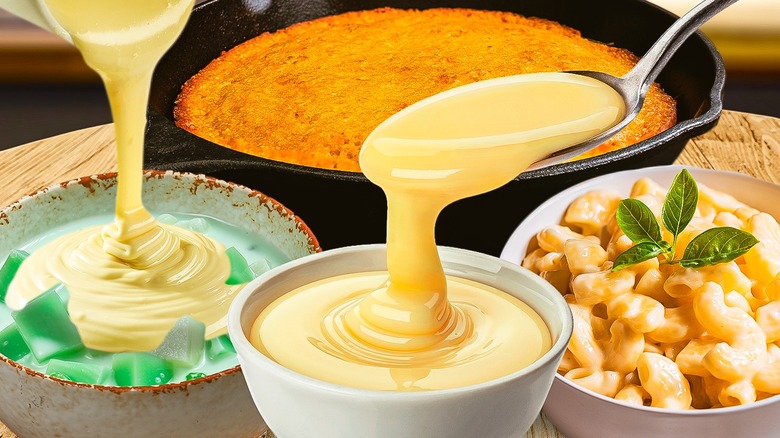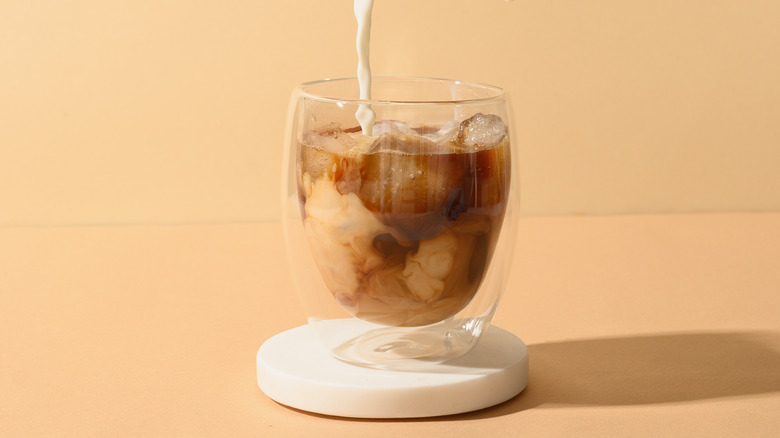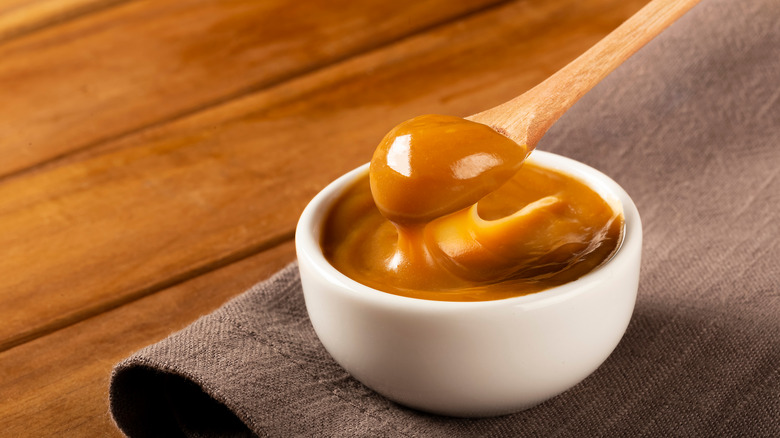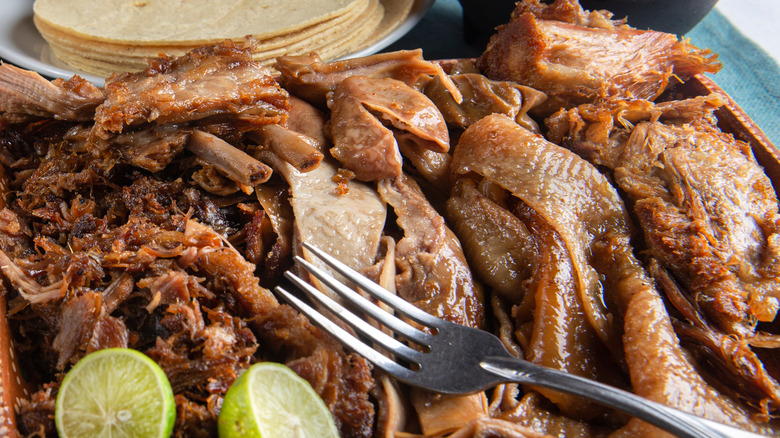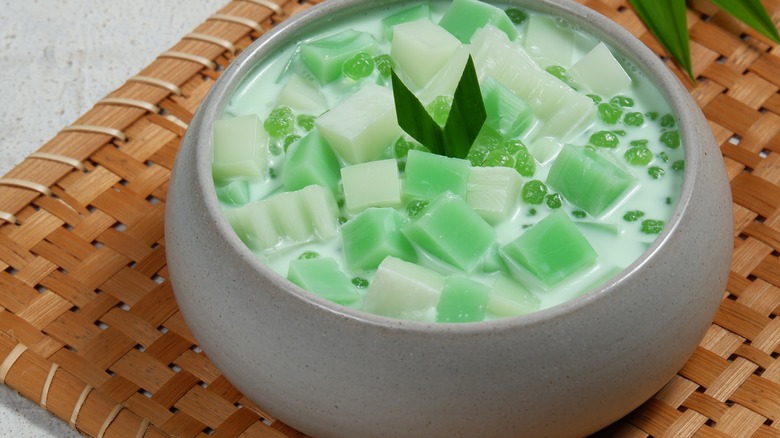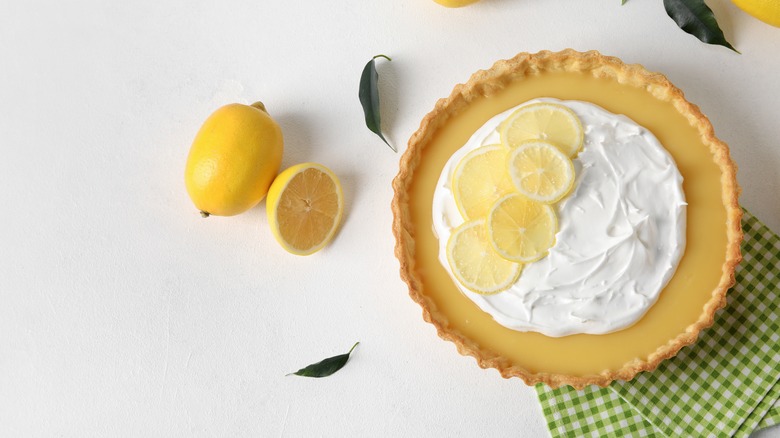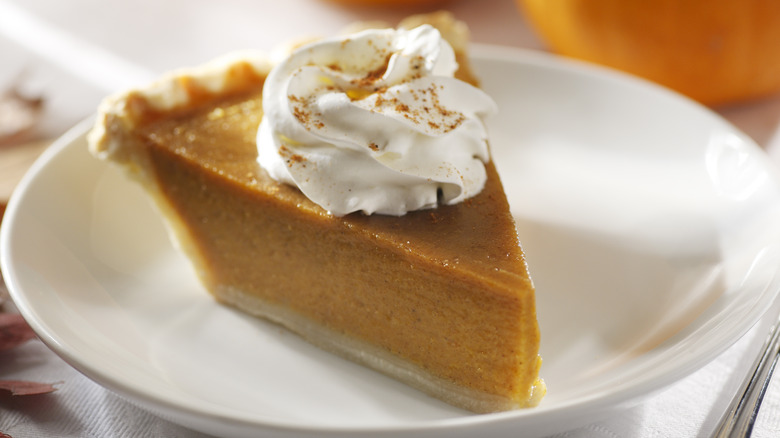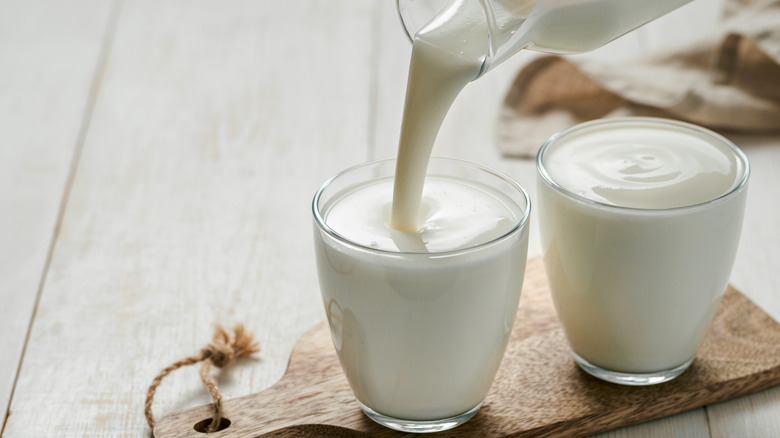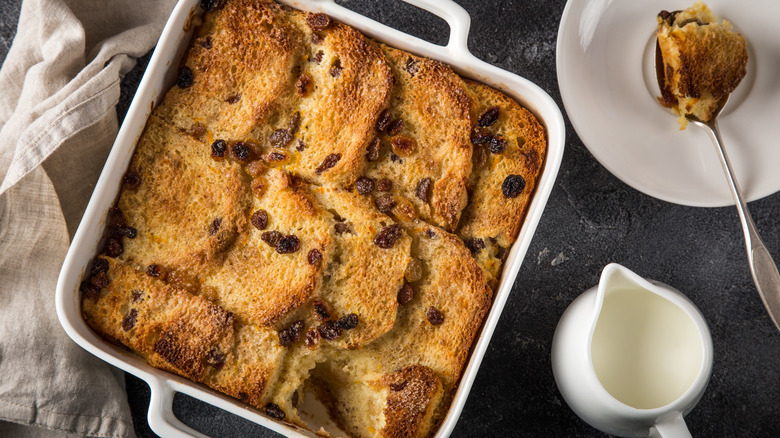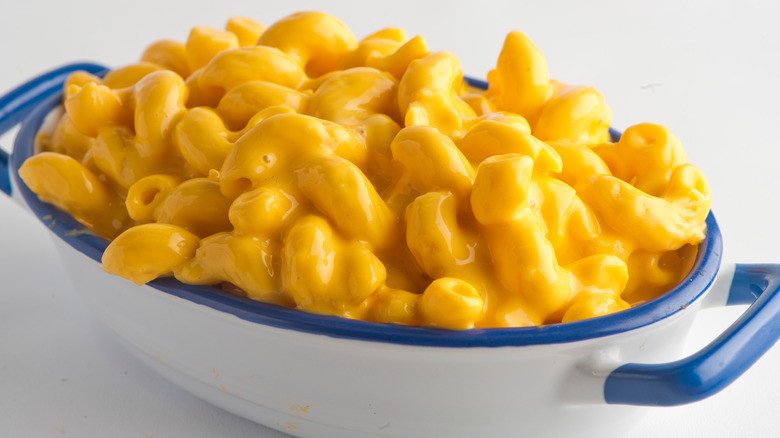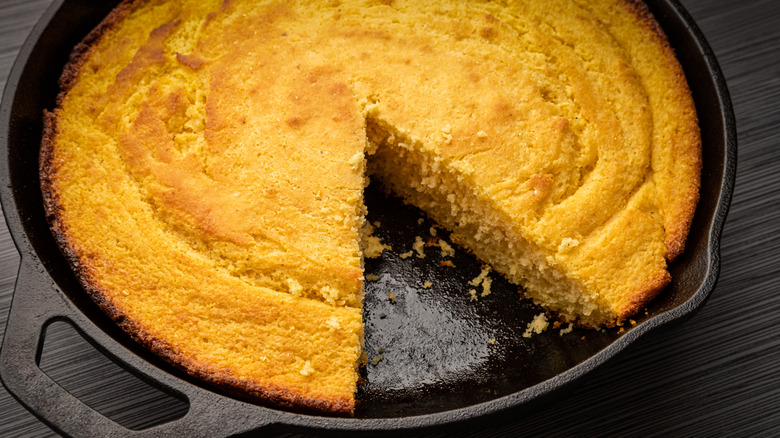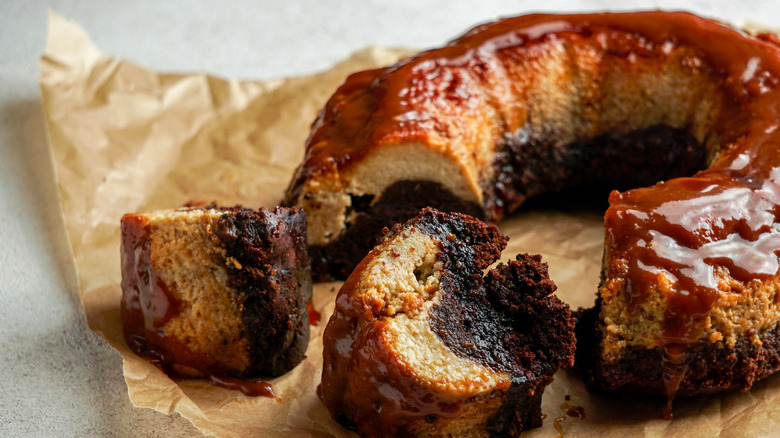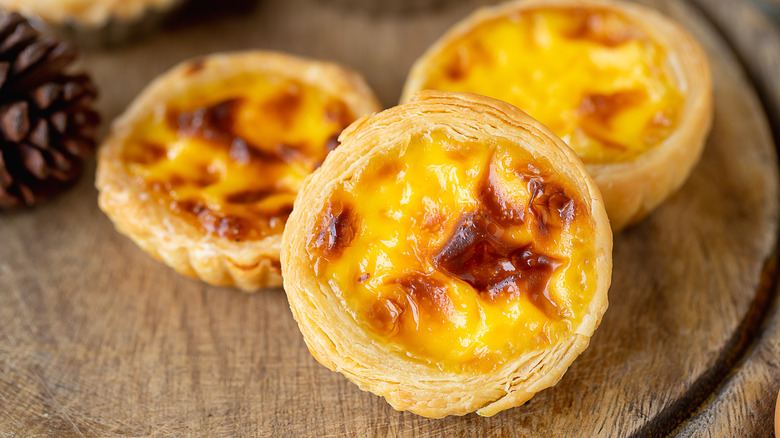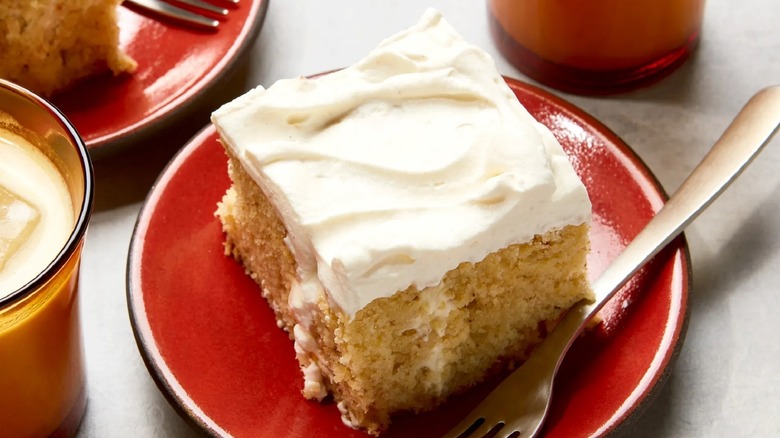12 Ways To Cook With Sweetened Condensed Milk
For many, sweetened condensed milk is one of those throw-away items in the canned goods aisle that is never bought unless called for in a recipe. But what is it, exactly? A mid-19th-century invention created before the advent of refrigeration, condensed milk is made by evaporating water from and adding sugar to raw milk. The addition of sugar and the canning process greatly extends the shelf life of the milk, making it stable at room temperature and an important field ration in World War I.
Today, sweetened condensed milk is still rather common in regional desserts around the world — including pies, tarts, and cakes — so you might find yourself annoyed, running to the grocery store here and there for a can of sweetened condensed milk at a recipe's beck and call. But recipes don't always use the entire thing, so what are you supposed to do with the rest of the can?
Believe it or not, this old-world milk in a can is a lot more dynamic and versatile than you might think. Whether sweet or savory or somewhere in between, these ideas for cooking with sweetened condensed milk might have you rushing back to the store to stock up for your next craving.
Vietnamese iced coffee
If you've ever eaten at a Vietnamese restaurant in the United States (or anywhere else in the world, for that matter), you've likely encountered the beautiful beverage that is cà phê sữa đá. While there are several variants of the drink, the main ingredients of this caffeinated delight are rather simple: ice, water, dark roast coffee, and sweetened condensed milk.
Traditionally, Vietnamese iced coffee is made by pouring hot water over ground coffee (typically a 2:1 ratio of water to coffee) into a filter called a phin, which rests atop a glass filled with condensed milk and ice. Once the coffee passes through the filter completely, the hot liquid is stirred into the glass, mixed in the sweetened condensed milk, and it becomes a chilled drink.
If you want to make your cà phê sữa đá like a pro, use Vietnamese-origin Robusta coffee beans. If you're not so interested in the whole rig, you can easily make your coffee however you normally do and pour it hot over the ice and condensed milk as described above.
Dulce de leche
Of the innumerable Latin American delicacies that have won our hearts, dulce de leche is one of the most delicious ways to cook with sweetened condensed milk. It's found in many forms, from individually wrapped hard candies to a molasses-thick sauce drizzled over decadent flan. Dulce de leche — literally to "milk candy" in English — is tasty and pervasive yet relatively simple.
Dulce de leche requires but one ingredient, which, if you're reading this listicle, you probably already have on hand: sweetened condensed milk. Dulce de leche is very similar to caramel sauce in that sugars are cooked down in a liquid until they caramelize, turning a light shade of brown. The only difference between the two is that the liquid in caramel is typically water, while that of dulce de leche is, of course, milk.
To easily make dulce de leche, simply take a can of sweetened condensed milk and simmer the can in water in a covered saucepan for about 2 to 3 hours until a caramel color is achieved. If your can is opened, make sure it is standing up in the water and that the level is not too high that it makes the can float The darkness of the caramel is up to you, but note that the darker the color, the more intense and the less sweet the flavor will be.
Use it to caramelize your pork shoulder
You may have seen soda-braised short ribs in a season of "The Bear," but braising meat in sweet stuff has been around for a long time. The same principle can be applied to pork shoulder, where cooking with sweetened condensed milk can lead to perfectly caramelized carnitas.
If you're unfamiliar with this technique, it might sound a little strange. But it's actually the same science behind making dulce de leche from sweetened condensed milk. As the carnitas slowly cook, the sweetened condensed milk begins to darken in color. Once the lid is removed from the pot, the liquid evaporates, and the pork sears and caramelizes in its own fat and the sugars that remain in the milk. The result is a beautifully browned exterior and fall-off-the-bone tender meat.
The recipe is rather simple. Simply season the pork on all sides with salt, and sear it over high heat in the braising pot to give it a nicely browned crust. Then, add spices and aromatics and cover the solid ingredients with water, chicken or pork stock, and a small amount of sweetened condensed milk. It should simmer covered for a few hours, then uncovered while the liquid reduces into a thicker sauce before being shredded. Use the savory and slightly sweet carnitas as a filling for tacos or burritos, a topping for nachos, or the star of the show in a rice bowl.
Make a classic Filipino dessert, buko pandan
Buko pandan is a Filipino dessert salad made with gulaman (jelly made of dried agar algae or carrageenan seaweed) or gelatin, young coconut, fruit, and sweetened condensed milk. It's more of a sweet soup or fruit cocktail, with lots of flavors and textures coming together in each dynamic bite.
This sweet concoction was conjured up during the American occupation of the Philippines as a Filipinized version of fruit salad. Buko is Tagalog for young coconut meat, and pandan refers to the fragrant leaves of the screwpine plant. This is one way of cooking with sweetened condensed milk that doesn't require cooking at all.
Making this Filipino delicacy is pretty low commitment, with only a few ingredients that can be easily found at most Asian supermarkets. While there are many variations of buko pandan, the mainstays include jelly cubes, pandan extract, coconut, nata de coco, and sweetened condensed milk, which helps thicken and sweeten the liquid in the salad for better flavor and texture. You'll add your condensed milk after your agar-agar or gelatin has been bloomed in hot water with pandan extract, molded, and diced. It often goes with a scoop of vanilla ice cream or toasted rice puffs.
Whip up a sweet and tangy lemon pie
Maybe you've got an excess of lemons from your backyard tree; maybe you're just crazy about citrus desserts, or maybe both. Either way, this Atlantic Beach lemon pie is an ideal way to use a can of sweetened condensed milk. This recipe adds surprising ingredients to a classic dessert, such as saltine crackers. The mild salt from the crackers is complemented well by the sweetness of the sweetened condensed milk, and the milk is complemented by the tangy acidity of the fresh lemon juice and zest. Altogether, this few-ingredient dessert is crunchy, smooth, zesty, and creamy.
Make your pie crust by combining crushed saltine crackers, sugar, and butter until a flaky dough forms. This can be done by hand or quicker by pulsing in a food processor. Form the dough around the inside of a pie dish and chill briefly before baking it solid in the oven for a few minutes. While it cools, make the pie filling with egg yolks, sweetened condensed milk, fresh lemon juice, and lemon zest. Fill the cooled crust with the filling and bake at 350 F until set.
Let the pie cool and top with whipped cream and candied lemon peel, and serve with an unsweetened beverage like coffee for a lovely, well-balanced dessert.
Please the crowd with creamy pumpkin pie
What could possibly make pumpkin pie better? You guessed it. Sweetened condensed milk works in a similar way for pumpkin as it does lemon pie. When the milk is added to the mix of pumpkin and eggs, it allows for a smooth, even mixing of all the ingredients that helps bulk up the sweetness from the pumpkin.
The addition of sweetened condensed milk to any simple pumpkin pie recipe will make the pie filling moister, lighter in color, and creamier. By adding it in, the milk helps keep the pumpkin filling emulsified and reduces moisture loss. Crack open a can and add it with pumpkin, eggs, salt, and autumnal spices. The sweetness and creaminess of the milk negates the need to add additional milk and sugar to the mix.
Fill a pie crust with the mixture and bake at 350 F until the pie is set. Serve with vanilla ice cream, whipped cream, or both. To make things even more interesting, try spicing things up for Thanksgiving by adding espresso or gingersnap cookies to your pumpkin pie to contrast the sweetness and creaminess of the filling.
Ferment some Vietnamese cultured condensed milk yogurt
Like many Vietnamese staples, yogurt was introduced to the region during French colonialism. Vietnamese yogurt, called sữa chua or da ua, uses condensed milk as well as fresh milk, as the canned variety was once more common in the country. While most recipes for sữa chua use regular condensed milk, sweetened condensed milk can be used all the same for a more syrupy version of the yogurt.
A yogurt starter — or active bacterial colony — is necessary to ferment the sweetened condensed milk. While probiotic powders and other yogurt cultures are available in their pure forms online, introducing a yogurt culture to your milk can be as simple as buying live yogurt at any grocery store and mixing it in with the milk. In addition to a few ingredients, a yogurt machine, which incubates the milk at a consistent temperature, is also necessary to properly ferment the yogurt. These can be found online or in most retail stores.
To make sữa chua, mix whole milk, sweetened condensed milk, and yogurt and microwave until lukewarm. Pour the mixture into the yogurt maker and heat to 90 to 100 F for eight or nine hours or until the desired acidity to taste is achieved. Refrigerate the yogurt for up to two weeks in the fridge.
Make rich bread pudding with leftover bread
Bread pudding classically uses regular whole milk in most recipes, so who's to say it can't be leveled up to be even richer and more delicious? It's one of the best ways to use up leftover ingredients, but it will taste like a mountain of intention and care has been put into it.
Diluting the sweetened condensed milk with a bit of water allows it to more readily penetrate the pieces of bread, which soaks up the mixture and makes it moist. The sugars in the milk enrich the bread, giving it a crisp and golden brown exterior and soft and moist interior once baked.
To make the custard, combine the condensed milk with a bit of hot water and allow it to dissolve. Then, add in eggs, brown sugar, melted butter, vanilla, and ground cinnamon and fully incorporate. Mix in the chunks of bread and other desired ingredients, such as raisins or dried cherries, and allow the custard to get absorbed by the bread. Bake uncovered until the pudding is golden brown and crispy on the outside and a cake tester comes out clean.
Make a well-balanced mac and cheese
Sometimes, nothing beats the effort of making a special homemade mac and cheese. Stir the pot a bit by using extra sharp cheddar cheese in combination with small amounts of sweetened condensed milk. Not many recipes out there call for the use of sweetened condensed milk, probably out of fear that the result might be too cloying. You can avoid a disastrously sweet mac and cheese by controlling the amount of condensed milk and contrasting it with complementary flavors.
Some recipes that call for sweetened condensed milk in mac and cheese suggest using it after alternating cooked macaroni with shredded extra-sharp cheddar cheese, layer by layer, in a casserole dish. Then, you'll pour over a mixture of sweetened condensed milk, evaporated milk, and eggs before baking. This is a simple shortcut way to make mac and cheese without a cheese sauce but could result in an imbalance in the flavors.
One way to ensure consistent flavor is by making a French mornay sauce using cheddar and milk. The sauce can be made the traditional way, with the addition of a few tablespoons of sweetened condensed milk and the substitution of a more piquant extra-sharp cheddar for a richer Gruyère. Pour the sauce over cooked macaroni and stir until the pasta is fully coated.
Break out the cast iron and make quick skillet cornbread
Like mac and cheese, some things are just better when they're homemade. It's hard to beat the heart of Southern cooking with homemade cornbread, especially when sweetened condensed milk is thrown into the mix. Some of the best cornbread can be made entirely in a heavy-bottomed cast iron skillet, which helps transfer and distribute heat evenly. This even distribution of heat encourages a Maillard reaction, giving the cornbread a nice golden brown exterior from the caramelization of the sugars in the cornbread batter.
This caramelization can be taken up a notch with the use of sweetened condensed milk, which also helps enrich and moisten cornbread from the inside. It can be added in small amounts to most recipes, including in this cornbread with sage and honey recipe.
Just add a few tablespoons of sweetened condensed milk to your chosen cornbread batter and mix in thoroughly. Set the skillet over high heat (or preheat it in the oven) and pour the cornbread batter into it. The mixture should sizzle when it hits the pan. This will help create an evenly browned layer. Bake the cornbread in the skillet at 350 F until a cake tester inserted into the center comes out clean. Allow the cornbread to cool and flip it over on a large cutting board or platter to slice. Serve it as a side with chili, soul food, or for dessert.
Make a beautiful, multi-layered chocoflan
Also known as the Impossible Cake due to the way its layers trade places during baking, chocoflan is a multi-layered dessert that hails from Mexico. Basically, it combines flan and chocolate cake into one, Bundt-shaped dessert. It's dense, rich, and delightful when drizzled over the top with dulce de leche.
While chocoflan is a bit more laborious to make, it's very much worth it. It uses sweetened condensed milk for the flan as well as caramel sauce for garnish. The chocolate cake batter and flan mixture are made separately, then poured into a Bundt mold glazed with cajeta, or dulce de leche, to create two layers. The flan is thick and custardy, made of evaporated milk, condensed milk, cream cheese, eggs, and vanilla.
Once baked, you will notice that although the cake batter is beneath the flan mixture when the mold is put in the oven, the two layers have reversed order when it comes out. The cake is then inverted onto a platter, revealing two beautiful ring-shaped layers of flan atop the chocolate cake. You can drizzle more of the cajeta or dulce de leche over the entire thing or on individual slices when serving.
Make bite-sized Portuguese egg tarts
Portuguese egg tarts, or pastéis de nata, are a cute and delicious eggy cup of rich, smooth, and caramelized custard in flaky puff pastry. Pastéis de nata can be made with the addition of sweetened condensed milk and heavy cream and a reduction of water and granulated sugar. The added milk sugar will make for a thicker and richer tart.
Make the puff pastry dough the night before you plan on baking the tarts — it's rather time-consuming and requires proper resting and chilling in the fridge before it will be ready to divide and shape. The custard just requires simmering whole milk, heavy cream, sugar, and flour that are then slowly whisked into eggs, vanilla, and sweetened condensed milk.
When making the tart filling, make sure to add the sweetened condensed milk no more than one or two tablespoons at a time. Too much can make the filling overly saccharine, detracting from the egg flavor. Too little, and the tarts won't be custardy enough. The center should resemble a jammy egg yolk. The condensed milk filling can be made ahead of time and refrigerated overnight. Serve with ground cinnamon and powdered sugar sprinkled over the top, alongside coffee or tea.
Make a creamy poke cake
If you've never heard of poke cake, it's exactly what it sounds like. Basically, a poke cake is a cake that calls for the cake to be baked before holes are literally poked into it. The holes are then filled with a flavored liquid so that the liquid seeps into them and soaks into the cake.
Sweetened condensed milk is the perfect ingredient for making creamy poke cake. The condensed milk may be infused with another sweet flavoring ingredient, such as peanut butter or chocolate so that the cake soaks it up and distributes its flavor around the sponge. To make the cake, you can grab a box of cake mix and make the batter according to the box's instructions. Once the sponge is baked, let it cool.
Meanwhile, using a blender, mix the sweetened condensed milk with your ingredient of choice and blend until completely smooth to ensure even absorption. Poke holes in the sponge using a fork or a chopstick, penetrating deep enough to ensure the milk can reach the bottom. Pour the infused sweetened condensed milk across the surface of the cake and let it soak. You can leave the cake in the fridge overnight to soak it completely, although not all of us have that sort of control. Finally, decorate the top of the cake with your choice of toppings, such as pieces of candy, chocolate sauce, and whipped cream.
